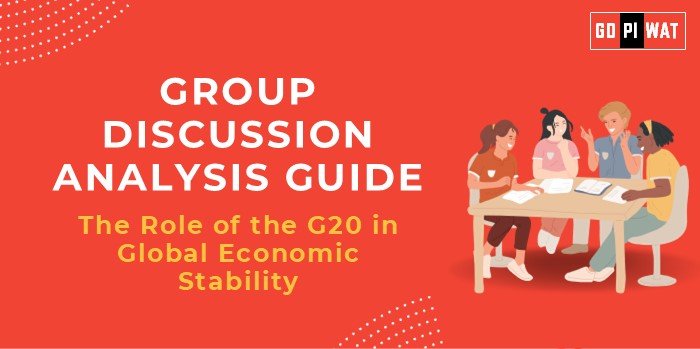📋 GD Analysis Guide: The Role of the G20 in Global Economic Stability
🌐 Introduction to The Role of the G20 in Global Economic Stability
Opening Context: The G20, comprising the world’s largest economies, is pivotal in addressing global financial crises and fostering economic stability. Its actions resonate across developed and emerging economies alike.
Topic Background: Established in 1999 post the Asian financial crisis, the G20 initially focused on global financial stability. Over time, its mandate expanded to include issues like trade, climate change, and digital innovation. The group represents 85% of global GDP, 75% of international trade, and two-thirds of the global population.
📊 Quick Facts and Key Statistics
- 💰 85% of Global GDP: Highlights the economic heft of the G20 economies.
- 📦 75% of Global Trade: Illustrates its dominance in international commerce.
- 🌍 2/3 of Global Population: Emphasizes its broad demographic representation.
- 🌱 Climate Finance Pledge: $100 billion annually for developing nations (committed at COP26).
- 💳 Debt Relief Initiatives: G20 Debt Service Suspension Initiative (DSSI) helped 73 countries during the pandemic.
🔗 Stakeholders and Their Roles
- 🌐 G20 Nations: Formulate and implement policies to address global economic challenges.
- 🏛️ International Organizations: IMF, WTO, and World Bank collaborate with G20 on global issues.
- 🏢 Private Sector: Participates in discussions on innovation, sustainability, and digital economy growth.
- 📣 Civil Society: Advocates for inclusive and equitable policies, ensuring marginalized voices are heard.
🏆 Achievements and Challenges
✨ Achievements
- 🌍 Coordinated global recovery post-2008 financial crisis.
- 💼 Initiatives like the BEPS (Base Erosion and Profit Shifting) framework to combat tax evasion.
- 🌱 Climate leadership with commitments to net-zero emissions by major economies.
⚠️ Challenges
- 📉 Inconsistent commitments among member nations on climate goals.
- ⚡ Tensions between developed and emerging economies on trade policies.
- 🛑 Limited enforcement mechanisms for compliance with G20 declarations.
🌍 Global Comparisons
- 🌏 ASEAN: Success in regional economic stability.
- 🇪🇺 EU: Role in driving climate policy as a unified bloc.
📚 Structured Arguments for Discussion
- Supporting Stance: “The G20 has effectively coordinated responses to global crises, showcasing its indispensability.”
- Opposing Stance: “Despite its influence, the G20 has struggled to enforce compliance and address inequality.”
- Balanced Perspective: “While the G20’s achievements are commendable, its potential remains underutilized due to geopolitical differences.”
💡 Effective Discussion Approaches
✨ Opening Approaches
- “With 85% of global GDP under its purview, the G20 is an economic powerhouse, but is it delivering enough?”
- “The success of the G20 post-2008 raises hopes, yet challenges persist in climate and trade domains.”
📌 Counter-Argument Handling
- 🌍 “Although compliance is weak, the G20’s discussions set a global agenda.”
- 💼 “Trade tensions exist, but they also highlight the importance of such multilateral forums.”
📈 Strategic Analysis of Strengths and Weaknesses
- 💪 Strengths: Economic representation, global influence, and crisis response.
- 🛑 Weaknesses: Lack of enforcement mechanisms and internal divisions.
- 🌟 Opportunities: Collaboration on digital economy, climate action, and sustainable finance.
- ⚠️ Threats: Rising protectionism and geopolitical tensions.
🎓 Connecting with B-School Applications
📚 Real-World Applications
Case studies on crisis management (2008), digital taxation frameworks, and climate finance.
🤔 Sample Interview Questions
- “How has the G20 influenced global financial policies?”
- “What role does the G20 play in addressing inequality?”
✨ Insights for B-School Students
- The G20 offers lessons on multilateral negotiations, policy framing, and cross-sectoral collaboration.


